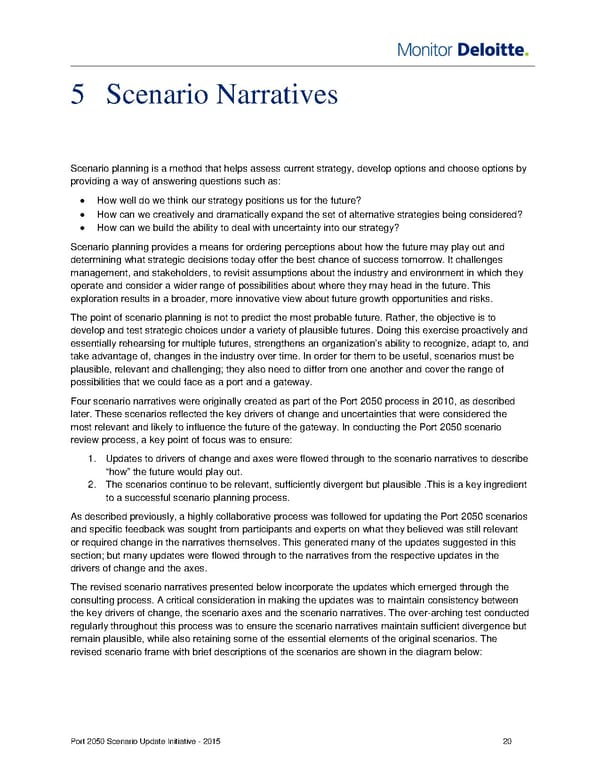5 Scenario Narratives Scenario planning is a method that helps assess current strategy, develop options and choose options by providing a way of answering questions such as: • How well do we think our strategy positions us for the future? • How can we creatively and dramatically expand the set of alternative strategies being considered? • How can we build the ability to deal with uncertainty into our strategy? Scenario planning provides a means for ordering perceptions about how the future may play out and determining what strategic decisions today offer the best chance of success tomorrow. It challenges management, and stakeholders, to revisit assumptions about the industry and environment in which they operate and consider a wider range of possibilities about where they may head in the future. This exploration results in a broader, more innovative view about future growth opportunities and risks. The point of scenario planning is not to predict the most probable future. Rather, the objective is to develop and test strategic choices under a variety of plausible futures. Doing this exercise proactively and essentially rehearsing for multiple futures, strengthens an organization’s ability to recognize, adapt to, and take advantage of, changes in the industry over time. In order for them to be useful, scenarios must be plausible, relevant and challenging; they also need to differ from one another and cover the range of possibilities that we could face as a port and a gateway. Four scenario narratives were originally created as part of the Port 2050 process in 2010, as described later. These scenarios reflected the key drivers of change and uncertainties that were considered the most relevant and likely to influence the future of the gateway. In conducting the Port 2050 scenario review process, a key point of focus was to ensure: 1. Updates to drivers of change and axes were flowed through to the scenario narratives to describe “how” the future would play out. 2. The scenarios continue to be relevant, sufficiently divergent but plausible .This is a key ingredient to a successful scenario planning process. As described previously, a highly collaborative process was followed for updating the Port 2050 scenarios and specific feedback was sought from participants and experts on what they believed was still relevant or required change in the narratives themselves. This generated many of the updates suggested in this section; but many updates were flowed through to the narratives from the respective updates in the drivers of change and the axes. The revised scenario narratives presented below incorporate the updates which emerged through the consulting process. A critical consideration in making the updates was to maintain consistency between the key drivers of change, the scenario axes and the scenario narratives. The over-arching test conducted regularly throughout this process was to ensure the scenario narratives maintain sufficient divergence but remain plausible, while also retaining some of the essential elements of the original scenarios. The revised scenario frame with brief descriptions of the scenarios are shown in the diagram below: Port 2050 Scenario Update Initiative - 2015 20
 Monitor Deloitte - Final Report Page 21 Page 23
Monitor Deloitte - Final Report Page 21 Page 23